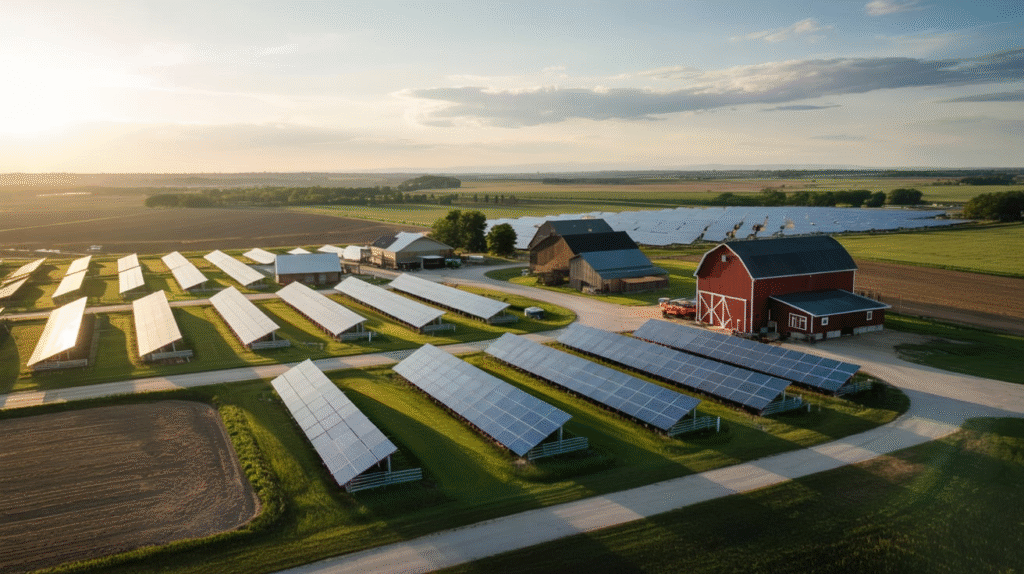From Small Towns to Solar Powerhouses: How Rural Communities Can Go Clean
The Energy Problem in Rural Areas
Most rural communities still rely on aging power grids. These grids are more likely to break down during storms or overloads. Fixing them takes longer. This leads to more outages and higher repair costs.

In many towns, electricity bills are also rising faster than incomes. The U.S. Energy Information Administration reports that rural households spend about 40% more of their income on energy than urban households.
Older homes and farm buildings aren’t always energy efficient. Heating systems, appliances, and insulation are often outdated. That makes energy use less effective and more expensive.
Why Solar Works for Rural Homes
Rural areas have one big advantage when it comes to solar: space. Most homes have wide, clear rooftops or unused land. That makes them ideal for solar panels.
There’s usually less shade from buildings or trees. And since many rural properties use more energy—for things like water pumps, large equipment, and heating—solar savings can add up faster.
Another perk is energy independence. Some rural customers are far from power stations. When outages happen, they can last days. Solar with battery storage can keep the lights on when the grid fails.
What’s Stopping Small Towns from Going Solar?
There are a few common barriers:
- Upfront costs. Even with tax credits, many people worry about how to afford the system at the start.
- Lack of local installers. In smaller towns, there aren’t always nearby companies that do solar work.
- Scepticism. People hear stories about scams, poor workmanship, or false promises.
- Policy confusion. Rural residents often don’t know what rebates, net metering, or incentives they qualify for.
These are real problems—but they’re also fixable.
Real Stories from Real Places
One crew member at Wolf River Electric recalled a project in a small Minnesota town. “The guy had five outages in one winter. His well pump went out, the fridge went warm, and he couldn’t work from home,” he said. “After we installed solar and a battery backup, he didn’t lose power again all season. He sent us cookies in the mail.”
Another job they handled was on a farm in North Dakota. The owner wanted solar to run irrigation and lighting for livestock sheds. “He told us flat out—‘If this doesn’t work, I’m taking it all down,’” a team member laughed. “Six months later he called to add panels.”
These stories aren’t rare anymore. More rural homes are turning to solar—and seeing it work.
Rural Incentives and Funding
Several funding options are now available for rural clean energy:
- USDA Rural Energy for America Program (REAP) provides grants and loans to rural businesses and farms for renewable energy projects.
- Federal Solar Tax Credit offers a 30% deduction on the total system cost for homeowners.
- State-level rebates and net metering let homeowners earn bill credits for unused energy they send back to the grid.
Some states also have utility-run incentive programmes specific to rural zones. These include cash rebates, free assessments, and equipment discounts.
Off-Grid and Hybrid Systems
For homes far from city power lines, going off-grid may make more sense than paying to extend service. Solar paired with battery storage and generators can run a home without connection to the main grid.
Hybrid systems are also growing. These stay connected to the grid but have battery backup in case of outages.
In places like northern Minnesota or western South Dakota, these systems are especially helpful during blizzards, windstorms, or summer surges when power demand peaks.
What Rural Residents Can Do Today
You don’t need to be a tech expert to start thinking about clean energy. Here are five things to try right now:
1. Get an Energy Audit
Check how much energy your home or farm uses. Many co-ops and utility companies offer free audits. They’ll tell you where you’re losing power and what to fix first.
2. Look at Your Roof
A good solar roof should face south, southeast, or southwest. It should get at least 5 hours of full sun a day. No heavy shade from trees or nearby buildings. If your roof won’t work, ground-mounted panels might.
3. Talk to Local Installers
Find someone who works in your area. Ask for site evaluations, project timelines, and references from other local customers. Be clear about your needs and budget. If they push too hard, move on.
4. Learn About Incentives
Use resources like DSIREUSA.org or your state’s energy office to check rebates and credit options. Some counties have extra incentives for farms, schools, or low-income residents.
5. Start Small if You Need To
You don’t need a full system right away. You can start with a few panels, a basic battery, or just a solar water heater. Add more later as your budget allows.
Why It Matters
Clean energy isn’t just a city thing. It makes real sense in rural places—especially where the grid is weak and bills are high.
Rural homes and farms can become their own power stations. They can cut bills, boost property value, and stay running when others can’t.
The more rural communities take charge of their energy, the less they rely on distant, failing infrastructure. That means more control, more comfort, and more freedom.
Final Thought
Going clean doesn’t have to be complex. It just takes a little curiosity and a few solid steps. And for many small towns across the Midwest, the shift has already started—quietly, steadily, one rooftop at a time.
